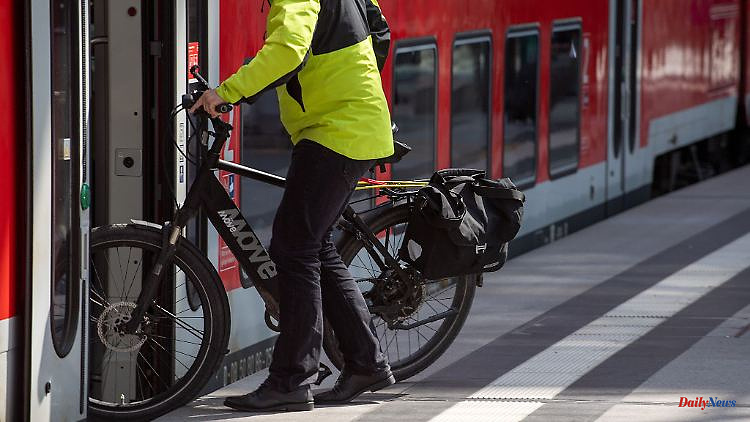As a commuter, when travelling: having a bike or scooter with you is practical, often cheap or even free. But it is not allowed everywhere. Guide through a jumble of rules.
With the folding bike or the e-scooter to the train station in the commuter belt, change to the Regio and from the destination train station the last few kilometers to the office: If you come to work using a mix of transport means, it is sometimes easier on your nerves than commuting by car. Plus: There is no need to search for a parking space, and you often save time.
Cyclists also like to use the train. But which ticket you have to buy, whether you need a reservation or whether you are allowed to board the bus and train with a two-wheeler at all cannot be answered in general.
The most important rules, tips and prices at a glance:
This applies to taking bicycles on long-distance Deutsche Bahn (DB) trains:
If you want to travel by bike, it is better to plan early. Bicycle parking spaces on trains are limited. On "bahn.de" or in the DB Navigator app, connections with possible bicycle transport can be displayed. Tip: plan more time for changing trains.
A reservation is included in the bicycle ticket price of 9 euros per connection. However, this does not apply, for example if travelers change their plans and take a later train. For this, a new reservation is necessary for 4.50 euros. The bicycle ticket itself is also valid for local transport (RE, RB and S-Bahn). But there are basically no reservations for bicycles here.
Railway competitor Flixtrain also allows bicycles to be taken along, but so far only on the Cologne - Berlin and Hamburg - Stuttgart routes. But the offer should be expanded. A bicycle space also costs 9 euros per connection. Booking early is also recommended.
This applies to regional rail transport:
The biggest difference to long-distance transport: you cannot make reservations, and bike transport cannot be guaranteed. With the extra "bicycle day ticket of the Germany tariff" for 6 euros, passengers can spontaneously board the regional train, depending on capacity, and travel through the entire republic by bike across the network.
The ticket entitles you to take your bike with you for any number of journeys on all local trains (IRE, RE, RB and S-Bahn) nationwide until 3 a.m. the following day. Children under the age of six can take the bike on board free of charge.
Bicycle tickets can also be booked within the regional transport associations. The advantage: In many places, bikes can also be taken on the bus or tram with a network ticket. However, individual regulations and prices vary by region and time of day. Deutsche Bahn offers an overview and links to the individual associations online.
This applies to taking the following on buses:
Flixbus is involved in long-distance transport. "You can take your bike with you on most of our Flixbusses," says the company.
If you add a bike to the booking process, only trips that have spaces available for cyclists with bikes will be displayed. Cost: 9 euros. However, you can only take your bike with you from March to October. The bikes are stored on bike racks at the rear or in bike covers in the luggage compartment.
In regional public transport, taking the bus with you is also permitted, as mentioned, but it is handled differently in the associations - for example with rush hour closure times. Here you should inform yourself locally.
Which types of bicycles are allowed and which are not?
Deutsche Bahn excludes the transport of cargo bikes. However, other, sometimes bulky bikes are allowed on board if there is enough space, for example tandems or recumbents.
Bicycles with electronic pedal support (pedelecs) are also allowed. The batteries must remain on the bike. Whether with or without a motor: the bikes must fit into the bike racks on board. The tires may be a maximum of 60 millimeters wide.
In the regional transport associations, the rules are different. Christian van de Sand from Stiftung Warentest therefore advises: "If a special bicycle is to be transported, it is best to read the respective transport conditions beforehand."
In principle, however, it is not possible to take S-Pedelecs with you, which support speeds of up to 45 kilometers per hour. Unlike pedelecs, they are not legally considered bicycles, but motor vehicles.
And folding bikes?
Folding bikes are generally regarded as luggage. The prerequisite is usually that they are transported folded up, the wheels are no larger than 16 inches and they fit in the luggage rack or under or between the seats.
An additional ticket is usually not necessary. Folding bikes are also suitable for rush hour, when normal bicycles are often not allowed to be taken on the underground and suburban trains, says Thomas Geisler from the Bicycle Press Service (PD-F).
In Flixbussen, a folding bike must be booked as special luggage (3.99 to 18 euros). At Flixtrain, a bicycle ticket must be purchased if the folding bike exceeds the dimensions specified for luggage - and this is the case with the current models.
This applies to taking e-scooters with you:
On long-distance trains, e-scooters can be carried as hand luggage free of charge if they are folded up and stowed away safely. The railway recommends a bag for this. If it cannot be folded, it may only be taken on board if there is space on luggage racks or shelves under and between the seats.
There are also different regulations in regional public transport. In Munich, for example, the small electric companions can be folded up free of charge in buses, trams, underground and suburban trains. "On the other hand, unfolded or non-collapsible e-scooters are excluded from transport," informs the ADAC.
In Berlin, for example, according to the Berliner Verkehrsbetriebe (BVG), you have to buy a bicycle ticket for e-scooters.
Flixbus and Flixtrain exclude the carriage of e-scooters across the board.
(This article was first published on Thursday, February 09, 2023.)












